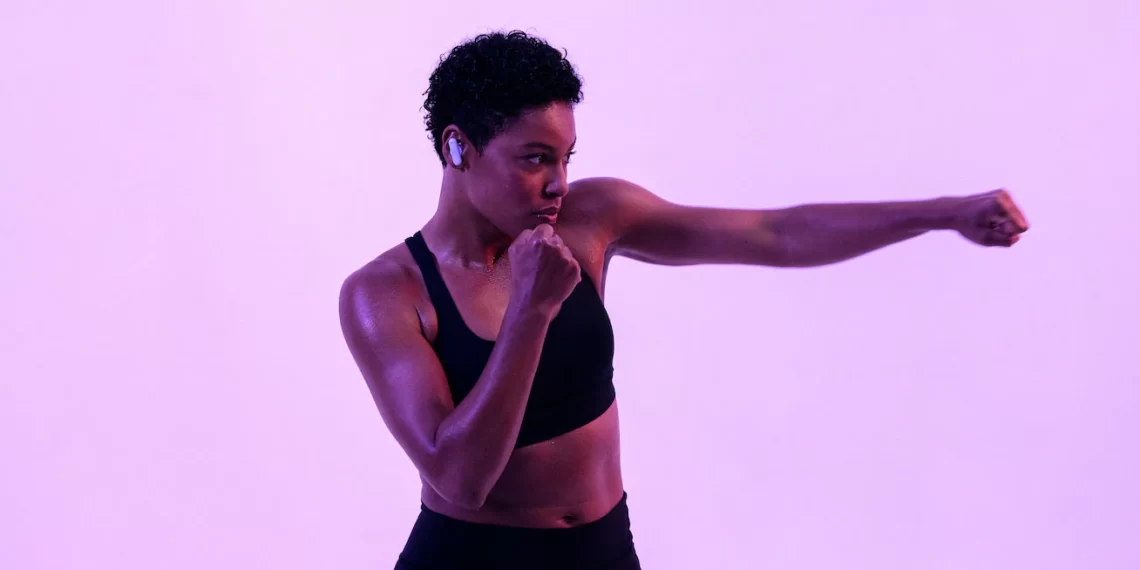Listening to music while you work out isn’t just fun, it can improve your workout by enhancing performance and boosting serotonin during your regular fitness regimen. And most fitness enthusiasts prefer to work out in earbuds.
Compared to headphones, earbuds are lightweight, portable and won’t jostle around too much while you’re exercising. Just imagine running a 5k with big, heavy headphones that bounce around with every step.
But not all earbuds are ideal for working out. When you’re shopping for that perfect pair of earbuds to help you get fit, here are some things to ask.
Are they Bluetooth?
Wired earbuds have long cable runs from your device to your ears. If you keep your phone in your pocket or a running belt, you risk tugging on those wires while you’re exercising, which will pull those earbuds right out of your ears. When you’re in the middle of your long run and are relying on Lizzo’s “Good as Hell” to help you get past the wall, the last thing you want is to awkwardly pull out your earbuds.
True wireless Bluetooth earbuds have absolutely no wires. Instead, they nest directly in your ear with nothing dangling from them. That means you don’t have to worry about wires getting tangled, damaged or tugged during your workouts.
Some Bluetooth earbuds, like our IPX Bluetooth cable for our CSX and PRO line, do have wires connecting one earbud to the other. This cable is typically worn behind the head, so it’s out of the way. While some people prefer the wire-free experience of true wireless earbuds like UE FITS, whether you prefer true wireless or a single wire is a matter of personal choice.
Are They Comfortable?
While you want to feel the burn during a workout, you don’t want any part of your body to be pinched or pulled—including your ears. Even the smallest discomfort can cause you to become distracted and get less out of your workout. You wouldn’t run in leggings with uncomfortable hems that scratch, so why would you want uncomfortable earbuds?
When it comes to earbuds, you traditionally have two options: hard plastic or soft rubber tips. Plastic tips aren’t ideal for working out because they aren’t made for your ears—which are as unique as your fingerprints—at all. Some folks are able to find a brand of plastic earbuds that work for them, but if your ears are bigger or smaller than average, it’ll feel like trying to stick a square peg through a round hole.
Earbuds with soft plastic tips are marginally better, but they’re still far from offering all-day comfort. Even if one of the multi-sized rubber tips included fits well enough in your ears, the plastic is still squishing against and pinching parts of your ears. That might be tolerable in bursts, but over the course of your longer workouts, it can become intolerable.

Do They Stay Put or Fall Out?
We’ve already mentioned that wired earbuds have a tendency to fall out when the wires get tugged, but that’s not the only reason earbuds fall out. Earbuds with plastic tips simply don’t “lock in” to your ears. Instead, they sit in your outer ear and can pop out even during low intensity workouts.
Earbuds with soft plastic tips are slightly better, but still not perfect. Though they often come with multiple tip sizes to choose between, there’s no guarantee that any of the tips will be the right size for your unique ears. Only a truly custom fit can lock into place so you can confidently wear them even during the most intense crossfit classes or trail runs.
Some fitness earbuds have built-in plastic loops that you can secure around the outside of your ears. These definitely help keep your earbuds in place, but not everyone finds them very comfortable. For example, if you work out in prescription glasses or sunglasses, these types of earbuds can feel awkward and uncomfortable. Others don’t like the added weight on their ears, and some people find them generally cumbersome.

Are They Resistant to Sweat?
While we know some folks who seemingly don’t perspire much even after an intense workout, most of us work up a sweat during our normal fitness routine. That means it’s extremely important to make sure your earbuds can handle moisture.
You’ll usually see either “water proof” or “sweat proof” when shopping for fitness earbuds. The difference is the IPX rating, which is a scale that measures how protected against moisture different electronics are.
Sweat-proof is rated between IPX3 and IPX6, which means they can withstand some moisture and splashing from rain or your sweat. Earbuds rated IPX7 and above can be immersed in water, but Bluetooth doesn’t work underwater, so you still wouldn’t be able to wear them while swimming. With that in mind, any earbuds that are at least IPX3 are ideal for exercise.
Working out in earbuds rated IPX2 or below is risky. You won’t be harmed by working out in earbuds that aren’t sweat-proof, but you might ruin your earbuds. Unless you’re planning on taking your earbuds in the pool, any earbuds that are at least rated IPX3 are safe to work out in.
How Much Outside Noise Do They Block?
When it comes to workout earbuds, the amount of noise reduction you’ll want depends a lot on where you’re working out. If you’re lifting weights at the gym, you probably want to block outside noise so you can get into the right headspace. But if you’re on your bike, you probably want to block the rushing wind sound while still being able to hear the sound of a car approaching.
There are two types of noise reduction in earbuds: passive noise isolation and active noise cancellation. Active noise cancellation (ANC) works by duplicating incoming ambient noise and cancelling it out by adding an equal and opposite signal to your music.
Meanwhile, passive noise isolation works by creating a strong seal between the earbud tips and your ears, keeping noise from getting into your ears in the first place.
For workouts, especially outdoor workouts near streets, active noise cancellation might make your runs a little less safe. If they cut out too much noise, you might not hear a vehicle drive by or an unfriendly dog approaching you. Some ANC earbuds have a “hear-through” feature that lets some noise in for the sake of safety, but not all do. Plus, earbuds and headphones with ANC aren’t able to faithfully reproduce recorded music without adding distortion to the music. In other words, they don’t sound as good.
Passive noise isolation can still block out the ambient noise in a gym or on the road. Our CSX earphones and PRO in-ear monitors can block out 26 decibels, which is on par with some ANC devices on the market. To put that in perspective, a passenger car in a neighborhood generally produces about 72 dB, so you’ll still be aware of traffic noises but won’t feel like your music is drowned out by them. And, because they don’t add any distortion to the audio signal, you can hear your favorite music in its purest form.
Regardless of the types of earbuds you work out in, you should always take care when running or biking on or near the street with earbuds.

How’s the Battery Life?
Even if you focus on HIIT workouts that only last 30 minutes, the last thing you want is to have to remember to recharge your earbuds after every workout. And if you’re planning on spending four hours running a marathon, you need earbuds that will last the whole race with you.
When shopping for earbuds that you plan on working out in, check to see what their average battery length is for music. A lot of earbuds will have different battery life metrics for listening and talking time.
Also look to find earbuds that can charge up to an hour or so of play time from a dead battery relatively quickly. For example, UE FITS offers an hour of listening time on ten minutes of charge time. That way, even if you forget to charge your earbuds before your mountain trail run, you’ll be running up that hill in no time.
An added benefit to true wireless earbuds like UE FITS is that they begin charging the moment you put them in their charging case. In the case of FITS, a fully-charged case can power up to 20 hours of listening time. That means you can charge your earbuds on-the-go instead of waiting near an outlet!
Do They Offer Tap Control?
When you’re in the zone, the last thing you want to do is take out your phone to skip a song or answer a call. That’s why it’s important to look for workout earbuds that offer some sort of tap control over the music on your phone.
Standard touch features include the ability to pause, play, skip, go back and answer a call. Some earbuds, like UE FITS, allow you to customize your touch controls to do exactly what you want them to do. For example, you can set your right earbud to skip a track when you double tap it while the left earbud can pause and play on a double tap.
Do They Sound Good?
Last but certainly not least, you deserve earbuds that sound good! Look to reviews that mention the sound quality of any workout earbuds you’re considering. Some earbuds even let you customize your sound between different presets to better match your personal preferences. For example, you might really want to boost that bass during a run and switch to a sound more tailored to spoken word when you’re out for a walk.

Get Fit with UE FITS
UE FITS are the world’s first custom-fit true-wireless earbuds. There are no wires to get tangled in and the custom fit means they lock into place perfectly for unparalleled all-day comfort. Plus, FITS are sweat-resistant and use passive noise isolation to block outside noise.
FITS offer up to eight hours of continuous listening on a single full charge and an hour of music listening after charging for just ten minutes. And at Ultimate Ears, we take sound quality seriously, so you can be confident that they’ll sound amazing.







